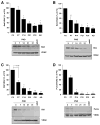Postnatal developmental regulation of Bcl-2 family proteins in brain mitochondria
- PMID: 18058945
- PMCID: PMC2566804
- DOI: 10.1002/jnr.21584
Postnatal developmental regulation of Bcl-2 family proteins in brain mitochondria
Abstract
Although it has been long recognized that the relative balance of pro- and antiapoptotic Bcl-2 proteins is critical in determining the susceptibility to apoptotic death, only a few studies have examined the level of these proteins specifically at mitochondria during postnatal brain development. In this study, we examined the age-dependent regulation of Bcl-2 family proteins using rat brain mitochondria isolated at various postnatal ages and from the adult. The results indicate that a general down-regulation of most of the proapoptotic Bcl-2 proteins present in mitochondria occurs during postnatal brain development. The multidomain proapoptotic Bax, Bak, and Bok are all expressed at high levels in mitochondria early postnatally but decline in the adult. Multiple BH3-only proteins, including direct activators (Bid, Bim, and Puma) and the derepressor BH3-only protein Bad, are also present in immature brain mitochondria and are down-regulated in the adult brain. Antiapoptotic Bcl-2 family members are differentially regulated, with a shift from high Bcl-2 expression in immature mitochondria to predominant Bcl-x(L) expression in the adult. These results support the concept that developmental differences in upstream regulators of the mitochondrial apoptotic pathway are responsible for the increased susceptibility of cells in the immature brain to apoptosis following injury.
2007 Wiley-Liss, Inc.
Figures





References
-
- Adams JM, Cory S. The Bcl-2 protein family: arbiters of cell survival. Science. 1998;281:1322–1326. - PubMed
-
- Becker EB, Bonni A. Pin1 mediates neural-specific activation of the mitochondrial apoptotic machinery. Neuron. 2006;49:655–662. - PubMed
-
- Bittigau P, Sifringer M, Pohl D, Stadthaus D, Ishimaru M, Shimizu H, Ikeda M, Lang D, Speer A, Olney JW, Ikonomidou C. Apoptotic neurodegeneration following trauma is markedly enhanced in the immature brain. Ann Neurol. 1999;45:724–735. - PubMed
-
- Blomgren K, Hagberg H. Free radicals, mitochondria, and hypoxia-ischemia in the developing brain. Free Rad Biol Med. 2006;40:388–397. - PubMed
-
- Chen L, Willis SN, Wei A, Smith BJ, Fletcher JI, Hinds MG, Colman PM, Day CL, Adams JM, Huang DC. Differential targeting of prosurvival Bcl-2 proteins by their BH3-only ligands allows complementary apoptotic function. Mol Cell. 2005;17:393–403. - PubMed
Publication types
MeSH terms
Substances
Grants and funding
LinkOut - more resources
Full Text Sources
Molecular Biology Databases
Research Materials

